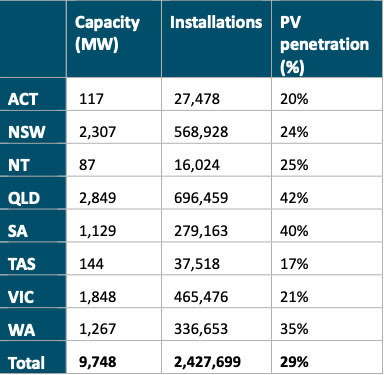WFH trend drives huge take-up of rooftop solar power

WFH has delivered a huge uptake in rooftop solar power: Getty Images
Working from home (WFH) has triggered a massive take-up in rooftop solar power with capacity up 41 per cent year on year in the June quarter.
Rooftop solar installation has driven jobs growth, with an extra 2,800 workers joining the sector in the first half of 2020.
“Key drivers of this growth include large numbers of people working from home, increased spending on home improvement and low interest rates,” the government’s Clean Energy Regulator said in its latest update.
ASX miners that supply battery metals are likely to benefit from the increased demand for household solar power systems.
Sunshine state increasingly powered by solar
Queensland is leading the way in the installation of rooftop solar power with 42 per cent of households in the Sunshine state having residential solar generation.
South Australia and Western Australia are next highest in terms of market penetration for household solar power at 40 per cent and 35 per cent, respectively.
The higher incidence of solar power generation in Adelaide, Perth and southeast Queensland is due to these areas having longer sun exposure and cheaper installation costs, plus prolonged government feed-in tariffs.
The Northern Territory has recently launched a renewable energy project for Alice Springs that includes solar.
In Australia, around 30 per cent of dwellings have rooftop solar power, representing 9,748 megawatts (MW) of generation capacity and covering 2.4 million households.

Rate of domestic solar installation accelerates
Installations of rooftop solar power systems added 677MW of generation capacity in the June quarter, up 41 per cent on year.
At this rate of increase, the Clean Energy Regulator’s estimate is for rooftop solar power to exceed 3 gigawatts (GW) by the end of 2020.
Total rooftop solar installations in Australia are capable of generating 12GW of power annually, and together they form the largest power generators in the electricity grid.
However, the high take-up of solar power in Australia is causing unique challenges, a report from the Australian Energy Market Operator (AEMO) said.
These challenges include uncertain performance during power system outages, and low demand during the middle of the day which can lead to volatility in electricity grid systems.
Cascading grid system failures a problem with more solar
“These challenges, if left unaddressed, could lead to system issues, voltage regulation issues, as well as cascading failures and potential blackouts,” AEMO said.
A solution to this problem could be residential and community batteries to store excess solar generation, thereby allowing small-scale solar to continue generating at high rates.
Several trials for community and virtual power plant batteries are underway in Australia to explore their viability as a source of coordinated grid stability.
In WA, community battery trials have led to the installation of 13 batteries ranging in size from 420 kilowatt-hours to 1.1 megawatt-hours.
Related Topics

UNLOCK INSIGHTS
Discover the untold stories of emerging ASX stocks.
Daily news and expert analysis, it's free to subscribe.
By proceeding, you confirm you understand that we handle personal information in accordance with our Privacy Policy.








